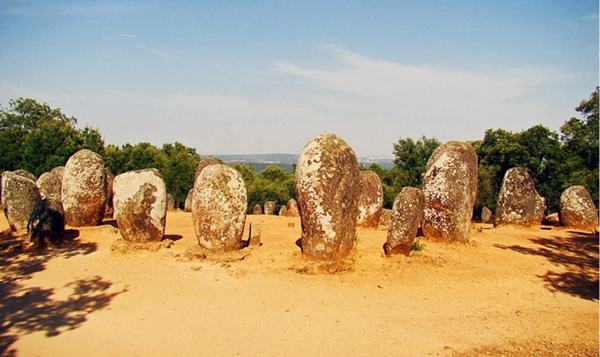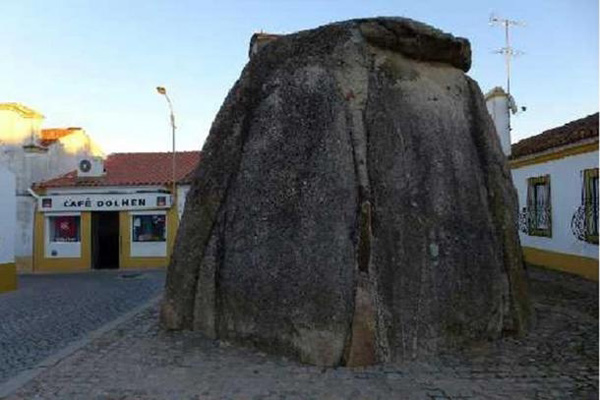Cromlec stone rings and legends of mystical women
Prehistoric Europeans passed down to the next generation of myths about powerful and mysterious women, who built stone tombs in Europe or cromlec stone.
Legend of mystical women

Almendres, Guadalupe, Evora, Portugal round stone complexes.(Photos: Wikipedia Commons)
In a master's thesis in 2014, archaeologist Henna Lindström of Helsinki University in Finland wrote about folk stories and legends that have been passed down for years, referring to supernatural people creating and protecting stone tombs. Portugal . Lindstrom's interesting essay details the stories from different parts of Europe about the Moura Encantadas , the name that Portugal used to call mysterious women.

The church destroyed many grave sites but publicly acknowledged other sacred places, one in Pavia, Portugal.(Photo: Henna Lindström)
The method of dating with carbon 14 isotopes shows that Europeans began to build this megalithic tomb between 4800 and 3800 BC, corresponding to the early Neolithic period. At the beginning of megaliths were large stones standing alone; then people made into a chrome ring. The people of Portugal were the first people to build megaliths, around 4800 BC. There are thousands of famous megaliths in Iberia.

The distribution of standing stones and stone circles from the Neolithic era in Europe.(Cromwell's map)
The description of the women who built them, ' Folklore clearly states that these women are powerful, they have immortality, youth, beauty and wealth, wisdom and skills, they teach those things to people. Most of these skills relate to the Moura . by the time of the Neolithic revolution, Moura taught people to spin, weave, make cheese, produce beer, plow and raise sheep, large and cows as a dish. gifts for people ', Lindström wrote.
She said linguistics connected Moura in Portugal to many other goddesses in Europe, including Greek god Moirae, or god Fates, who controlled human destiny with his mind and even Zeus must answer. God Fates, like in the Moura Encantadas, weaves the fate of mankind on the loom and cuts it at the time of their death.
' Linguistics also gives a hint about the duties of Moura goddesses by linking them with the theme of death and souls, and studying folklore linking them to life, the ability to give birth. Long life, health and wisdom, ' Lindström wrote.

Painting depicting three fateful gods of Francisco de Goya (Photo: Wikipedia Commons)
Legends have changed over time. Many more recent stories about Moura as Moorish women suffer from a father's mantra that keeps them young, so they can protect hidden treasures or in grave sites. They can transform shapes into snakes and are guarded by angry cows.
Other stories say that they live in a palace of gold and silver and are waiting for the day of freedom, the day a man comes to kiss Maura, in the form of a giant snake. Or that man must be eaten, then he will come back in human form again.
'These efforts have never been made, and the Moura are still sad and fall in love, and cry so much that their tears form rivers and lakes , ' Lindström wrote.
'However, the previous myth, not to mention the Moorish relationship or to be enchanted but instead said that they are living in the underground world of caves or dolmens and do not want anything from humans. except milk, which makes them addicted. They can possess treasure and exist in the form of goats, cows or snakes but are transformed in their own way. They have a moral challenge, and if that person deserves they can receive a reward. Moura is said to be harsh to cruel people. A failed man with Moura may have to die , "Lindström wrote.

Casa da Moura ('Moura's House'), a dolmens in Portugal (Wikipedia Commons)
In other legends recorded by Lindström from sources of data from Portugal written in the late 19th century, people sought Moura at noon, at midnight or mid-summer to help them heal. , wishing to have children or luck in love. Moura can test their xinxing before helping out. In other stories, the Moura are surrounded by rabbits, chickens and piglets, which can be used as gifts for humans.
There is another story saying that Moura appears as a sign that death is approaching or that she appears when a woman is difficult, or may even decide the outcome of childbirth, who is the survivor between mother and child.
The Moura are also said to have lived in this world before humans were created. When people appeared, they played heroes, teaching people to cultivate and raise animals, go to sea and wrought iron.

The stone tomb cut in Formos de Algodres, Portugal, is believed to be the place where Moura kneaded bread (Photo: Wikipedia Commons)
Another example of stone builders and destiny weaving is a document from the British Isles about Cailleach Bheara. Lindström writes:
"Like Moura, she is thought to be both young and old. She often transforms into a cow or buffalo. Like Babylon's Ishtar and German folklore, she rejuvenates herself by bathing in the sea. every 500 years in a certain lake.
Lots of people love Cailleach, and in some stories it can be a horned son. She dominates the weather, causing snow to fall by shaking the fluffy blankets for falling cotton. Besides the weather, Cailleach also dominated the crops. Winter begins and the landscape turns white as she washes her gray hood in a fjord, and spring comes when her hammer is thrown under a holly bush. Cailleach is older than any living thing, she has created all the landscapes in the world she lives in, and can remember every moment they change. She also built stone tombs, many of them named after her. She also moved in the underworld and talked to the dead. "

The megalithic tombs in Loughcrew in County Meath are located atop Slieve na Calliagh (meaning 'her mountain', alluding to Calliagh) and it includes a stone curb called 'her seat'.The T-shaped stone dock on the top of Slieve na Calliagh is a classical tomb hall, in which the sun rays shine down the aisle and light an interior room filled with megalithic sculptures.(Photos: Wikipedia Commons)
Lindström writes about one of the many genres of legend, in which the Moura ' appears here when the time begins and she shapes everything, hills, valleys and rivers, dolmens, vertical monuments and the red paintings on the rock, then the birth of children, who may be the ancestors of the community about this legend. So what was in this place before? A goddess with her own landscape, creatures and people in a cycle of life? May'.

Some megalithic tombs are decorated with paintings and plates.Two pieces of stone-like figures are in the Portuguese Museum.(Photo of Henna Lindström)
The characters written in stone tombs, Lindström said:
"Art and symbolism in Portuguese dolmens, and they point towards the Sunrise or Moon's feces, this can be seen as describing their faith in rebirth. Art. itself is used to guide people about life, death and rebirth, to move between the worlds of life and death, megalithic tombs are burial sites and burial places in doubt. ceremony, but it seems that it is not just that or that it is not its main function, it is likely that they are like churches in Christian times, the spiritual center that the community has celebrated together Important dates and events, to negotiate and agree on issues related to the entire community and to enhance character their community. "
She said that Christian bishops in later years banned annual celebrations around the grave. The Church also destroyed some dolmens and other holy relics. However, the legend of Moura still stands up over time.
- Wearing stones for her
- Controversial legends
- Wedding rings in the ancient world
- The 'magic' ring controls every device by gesture
- Records of dragons 'real' in history
- What is the truth in the legend of the sun stone?
- The mystery of the rings of supreme rings was used by the emperors in the Palace
- The 5 most mysterious legends in the magnificent city of Paris
- The mysterious legends of Halloween
- 1,700-year-old gold rings engrave love figures
- 'Ringing for help' helps save thousands of lives
- The legends of
 The truth about the mysterious red-haired giant at Lovelock Cave
The truth about the mysterious red-haired giant at Lovelock Cave Inunaki Tunnel: The haunted road leading into Japan's 'village of death'
Inunaki Tunnel: The haunted road leading into Japan's 'village of death' The mystery of the phenomenon of human reflection before dying
The mystery of the phenomenon of human reflection before dying 6 mysterious phenomena, although science has been developed for a long time, still cannot be answered
6 mysterious phenomena, although science has been developed for a long time, still cannot be answered